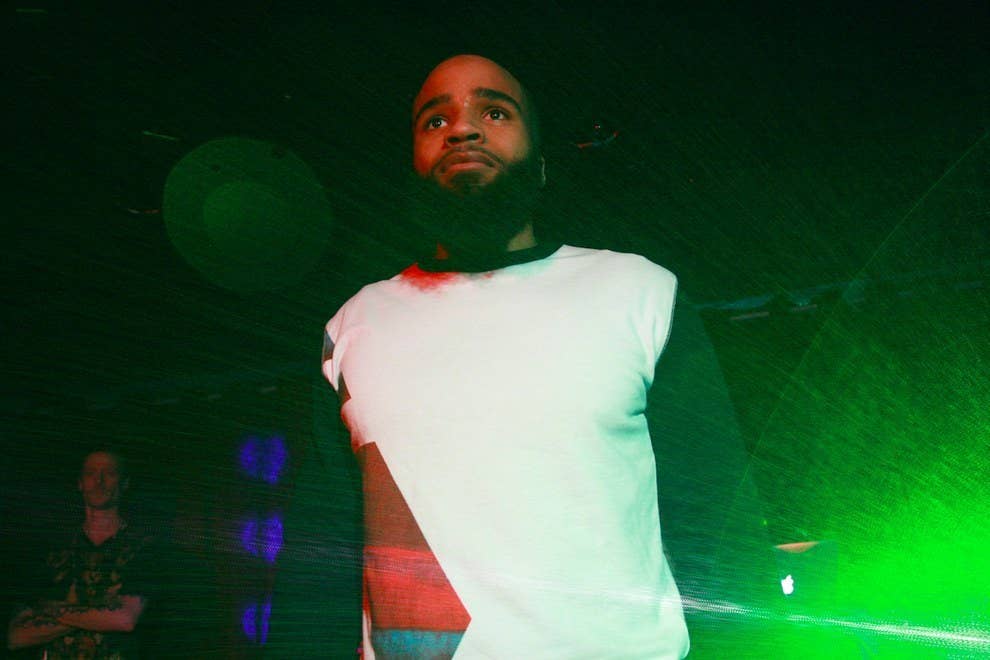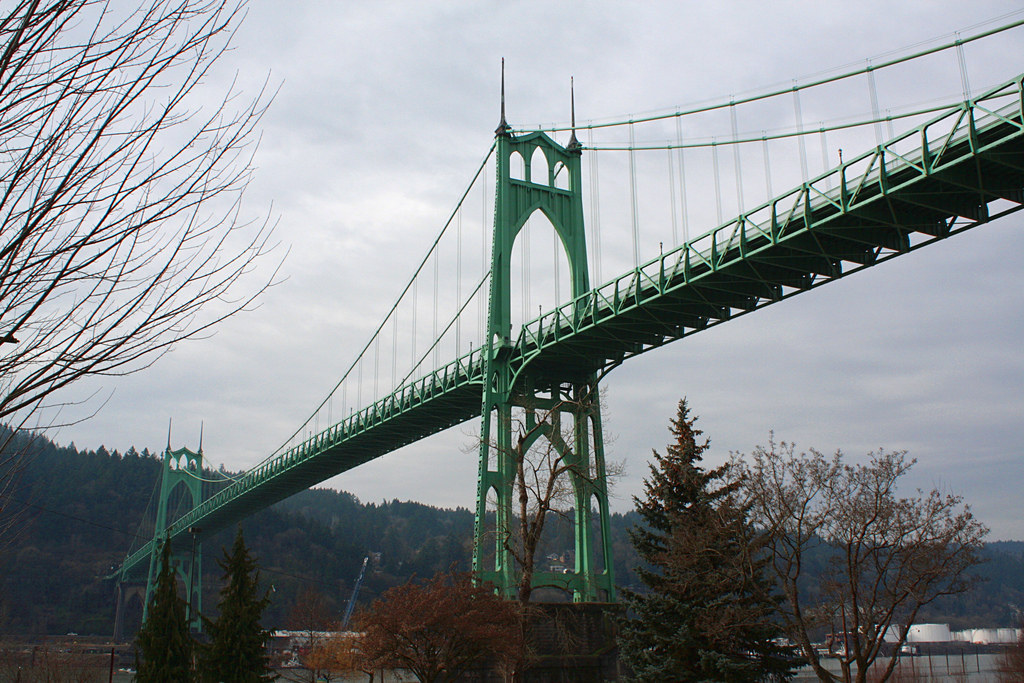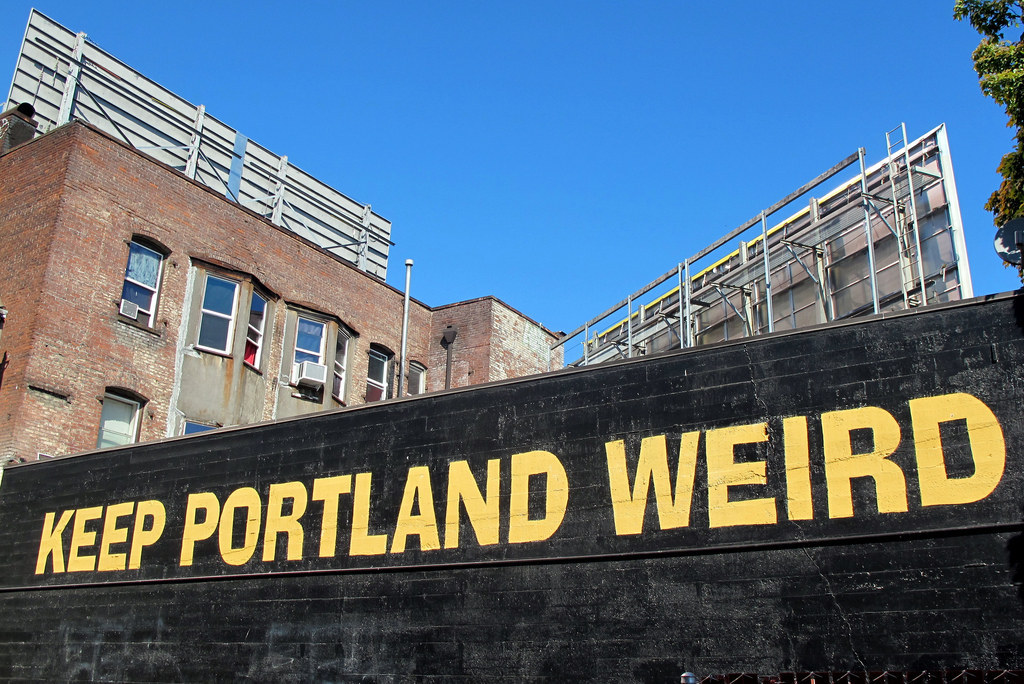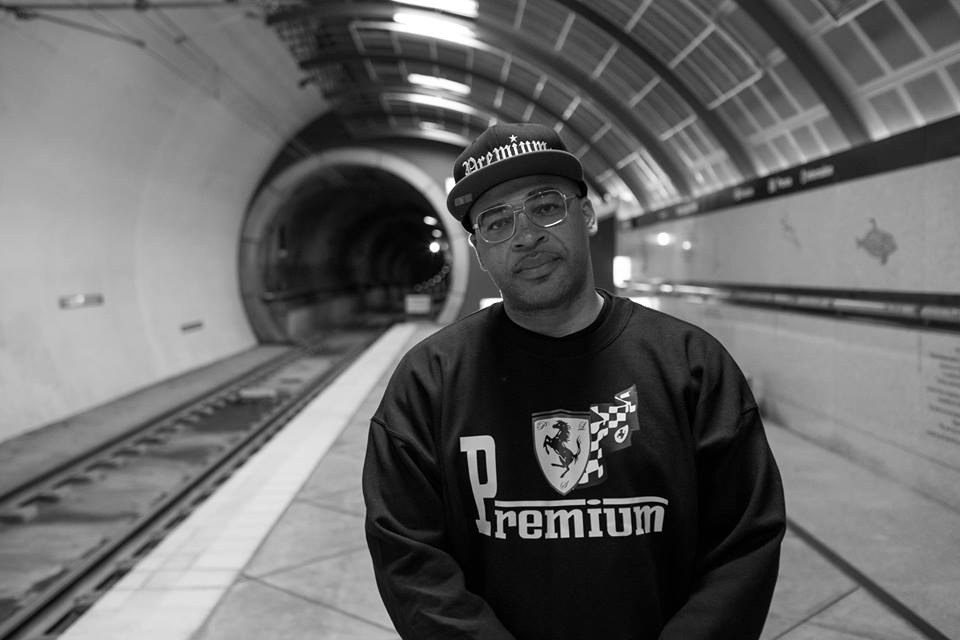
It’s after midnight on a Wednesday night in April, and Rasheed Jamal, a member of the rap trio the Resistance, is talking to the crowd at Holocene, a Southeast Portland, Ore., club. “I know it’s late and we’ve all got work tomorrow, so I’m going to let you guys decide: Should we do one more song?”
There are about 30 people left in the audience, and they shout for one more. “OK,” Jamal laughs. “Now when I say ‘love,’ you say ‘hip-hop’…”
The message is a fitting cap for the show, a four-hour mash-up of local pop, rock, and rap acts, which is itself a call to action. Local record company Party Damage organized the night as a gesture of support for Portland’s hip-hop community and minority populations, who’ve been having trouble with the police bureau and fire marshal, reviving long-standing conversations about discrimination around town.
Portland, despite its reputation as a hub of young, progressive creatives, is also a city with a remarkable lack of diversity; according to the 2010 U.S. Census, 76.1% of its population is white. The city’s recent rapid development has led to a feeling of further marginalization among non-white communities, and those frustrations are being expressed vocally within the local hip-hop scene. But while that community feels it’s being targeted and pushed out, the city’s cops feel their actions are being misunderstood. Who is right, and is it possible for a black community to have a thriving voice in the whitest major city in the country?
Party Damage dreamed up this midweek party after another one, at an unassuming Portland jazz bar called The Blue Monk, was shut down. On March 1, three of the city’s most-loved rappers were set to perform there. The men on the lineup — party rapper Mikey Vegaz, self-proclaimed “King of the Northwest” Luck-One, and national freestyle champion Illmaculate — all in their twenties, have built up local cred after years of performing. Hyped around town as a showcase for The Heavyweights of local rap, the show sold out — but the unexpected arrival of the cops and fire marshal quickly shifted the tone, and spurred a citywide discussion of its treatment of the hip-hop community.
The first pair of police officers arrived 20 minutes into the night’s opening set. According to organizer and promoter Bryce Trost, the cops asked that Mikey Vegaz (born Eddie Bynum Jr.) be pulled from the stage for questioning. When Trost refused, he says, the officers threatened to shut the show down. “[The police] were trying to provoke something,” Trost says. “But when they saw — surprise!— nothing bad was going on, they started looking around, saying, ‘Oh, well, you know, this place looks pretty crowded.’”
The fire marshal was called to the scene to count heads, and over the course of another hour, a dozen additional officers, some members of the gang task force, arrived. Trost says the officers ignored his offer of an “accurate tally” from the box office attendant. Showgoers were ushered out; many were prevented from re-entering. Illmaculate, whose real name is Gregory Poe, took to the stage amidst the commotion, and announced that he would not be performing. Outside of the bar, located in the residential Belmont neighborhood, traffic was blocked by squad cars. No criminal activity had taken place.
For Illmaculate, who’s been performing since he was 17, the “overt display of authority” was familiar. The night before the Blue Monk show, police had interfered with a Black History Month event featuring rap performances at North Portland warehouse venue Odyssey. His refusal to perform at Blue Monk, he says, was about “frustration.” That night, he expressed disappointment on Twitter: “I will not perform in this city as long as the blatant targeting of black culture and minorities congregating is acceptable common practice.”
“The hope was to burst some bubbles,” says Casey Jarman, the co-founder of Party Damage Records, of the April Holocene show. He planned it in conjunction with an open letter in the Willamette Week in April, calling for Portland music fans to rally in support of the hip-hop scene. “Portland is a progressive but also really segregated city,” he says. “Not just racially, but culturally. I think that everyone involved with this show has expressed interest in breaking down those barriers and seeing what would happen.”
At the party, the bar serves a rotating selection of alcoholic slushies. Most of those in attendance, in oversize sheet tops, high-waist jeans and vintage sweaters, would fit in easily in the background of a Portlandia sketch. Tucked discreetly between the bar and the permanent photo booth, representatives from the ACLU of Oregon are manning a table stocked with wallet-size pamphlets on citizens' rights.

Three police reports about the Blue Monk show, filed on March 1 and March 2, provide different explanations of what happened. One claims that the first pair of police officers to arrive stopped by as a routine check-in, the kind that cops in the bureau’s Entertainment Division, which is in charge of monitoring the city’s bars and nightclubs, do all the time. The venue was overcrowded — Sgt. Eric Strohmeyer’s report says backup officers were called to clear 120 people from the bar. One of the reports also notes that police suspected gang activity at the show. Peter Simpson, a Portland Police Bureau public information officer, later told me that Mikey Vegaz is “known by the gang enforcement team” and has been “the subject of investigations.”
But there’s a remarkable discrepancy between the way showgoers and police describe the night. “Apparently the officers received sort of hostile responses from people in the crowd, and one of the performers was inciting that by some words,” Sgt. Simpson said. The police reports cite “anti-police lyrics” like “All they want to do is hold us down and beat us on the ground.” (Likely, these are misheard lyrics from Luck-One’s “Sounds of My City II”: “Where the coppers only judge us / To show us they never loved us / They beat us up and they cuff us on the ground.”)

Meanwhile, the officers ascribe hostility to the audience and performers. Mac Smiff, who is rapper Luck-One’s brother and runs northwest hip-hop blog We Out Here, described the scene as “a police takeover” with officers blocking doors; Trost says it looked “like a murder scene.”
Having lived most of his life in Portland, Smiff has witnessed the gentrification of the city’s neighborhoods. “The Blue Monk thing was so surprising,” he says over coffee in April. “The police had always kind of kept their scope downtown, but now they’re on the east side, and we’re like, wait, we can’t do hip-hop over here anymore? Are we gonna have to go all the way to Estacada [a small city 30 miles southeast of Portland] to do it? There’s a feeling of being pushed out, and the black community has already been there.”
As Kiran Herbert outlined in Guernica magazine, 19th-century lawmakers were determined to keep Oregon white, ordering freed black people out of the state and making black migration into the state illegal. These laws were repealed by the 20th century, but real estate agents continued to deny housing to minorities, pushing black citizens to less desirable neighborhoods at the town’s northeastern edge.

Today, historically black neighborhoods like Alberta and Mississippi are gentrifying — their coffee shops and bookstores appear regularly on Portlandia. A significant number of Portland’s rappers, including Illmaculate, are coming out of St. Johns, a neighborhood on the city’s far-north outskirts that’s historically been one of the city’s most diverse, and poorest. But even St. Johns is changing. For 2012’s “Lost Our Soul,” Illmaculate wrote: “They putting newer structures up / That they build in a month [...] They want us to move out / Turn our buildings to dust.”
As Portland’s economy has grown, a string of businesses serving Portland’s black community have closed. There was the popular restaurant and nightclub Greek Cusina, which shuttered in 2010 after run-ins with the fire marshal and city commissioner. Former owner Ted Papas would later claim the establishment was unfairly targeted for aggressive and unjustified code violations. The popular nightclub Fontaine Bleau had its liquor license suspended and ultimately closed its doors after a fatal on-site shooting in 2013; on May 27 of this year, owner Rodney DeWalt filed a suit against the city and the OLCC for their “campaign intended to thwart black-owned clubs or clubs that played hip-hop and catered to the Black community.” The Blue Monk itself closed in April 2014, though former owner Sheri Dietrich tells me the controversy surrounding the March show was not a factor.
Chase Freeman, a promoter who booked hip-hop DJs at the now-defunct Beauty Bar, says police enforced dress codes at nightclubs, while the OLCC and fire marshal intimidated venue owners with threats of inspections. He says authorities don’t have a problem with hip-hop in itself, but with the congregation of black crowds. “They say they’re concerned about dangerous situations, but what they really mean is [situations with] a shit-ton of black people,” he says. “The police are not going to let [hip-hop] fly. It’s not how they want Portland to look.”
Luck-One, one of the rappers booked for the March Blue Monk show, moved from Portland to New York in January, saying the city had become, for him, unwelcoming. “I personally am not interested in trying to make any more of a name in a city so racist the police are sent out to every rap show to terrorize concertgoers in an attempt to re-create the city in the image of a cable TV satire,” he says.

Hip-hop’s struggle to thrive in Portland isn’t a new one. Cops there have linked violence and hip-hop for years. In August 2006, four people were shot in a parking lot about a block from the Roseland Ballroom venue following a Keak da Sneak concert. The incident prompted then-Central Precinct Lieutenant Todd Wyatt to tell the Portland Mercury, “It’s not a coincidence that all these shootings happen after a rap concert. We don’t want to say that because we don’t want to be labeled as racist, but if you line up the shows, and line up the numbers, there’s a correlation.”
When I meet with Simpson in his downtown office in April, he seems hesitant to connect rap shows with trouble as directly as Wyatt once did. When I ask if he believes the Entertainment Division watches rap events more closely than rock shows, he responds with a deep sigh. “Well unfortunately, it’s which came first, the chicken or the egg?” he says. “I mean, we have had hip-hop shows or events that have had tragic consequences.”
He gestures to the Willamette River behind him and recounts a gang-related shooting that occurred in August 2013, while 300 people waited to board the Portland Spirit cruise for an after-party Simpson says followed a live hip-hop performance. Three men were injured, one critically. “Is it hip-hop’s fault?” Simpson asks. “Absolutely not. It’s the people that were going there, the small number of people as part of a larger group, that created that problem.”
But a phrase like “small number of people,” while vague enough to deflect criticism, is broad enough to protect most police action. Like the possibility of overcrowding, suspicion of gang activity is a practically irrefutable justification for police entry into a bar or a show. But Mac Smiff and promoters Chase Freeman and Bryce Trost all insist that there are not gang members in their music community, and that many of the people on the gang task force’s list are there wrongfully, perhaps just for being born in the wrong neighborhood. In a city as small as Portland, a gang tie might actually just be running through overlapping social circles.

The performers, promoters, and officers I spoke to all agree that shows should be safe. But if police will treat hip-hop gatherings as dangerous until proven otherwise, Portland’s rappers hope at least that the system putting them on defense might become more transparent. Selling tickets and merch, they’re entrepreneurs, and they would like a fair shot at building their businesses.
They’re not the only ones. The OLCC is notoriously stringent, and thriving in Portland as a late-night establishment is a feat, no matter what type of music you play. (Recently, Portland City Council announced it’s considering a special permit requirement for businesses open past 10 p.m.) But Trost, who has organized art shows, poetry slams, and concerts of all genres, says by far it’s the planning of a hip-hop event that requires jumping through the most hoops: from combing through the social media presence of artists he’s booking so he can answer cops’ questions on the night of show, to finding a venue that won’t drop out at the last moment. In the last six months, he says, he’s had to reschedule 14 shows.
Police admit that poor communication has built tension between them and the hip-hop community. Cops showed up at the Blue Monk on March 1, Simpson says, because they had only minimal information about the event. And ultimately, he says, “we found we didn’t need to be there.” Without much of an explanation, though, Simpson understands why the Blue Monk crowd felt disrespected on the ground, and why talk of discrimination proliferated after. “This is truly a perception issue more than a reality issue,” he argues, before conceding: “We recognize, though, that perception is reality for people.”

Veteran local performer Cool Nutz, whose real name is Terrence Scott, says that to successfully grow a music career in Portland, rappers must proactively seek out dialogue with the powers that be. “[Portland] is not New York or L.A.,” he says, talking about creating a niche for hip-hop acts in an indie-rock market. Scott’s shows go smoothly, he says, when he takes care to talk to police, the OLCC, or the gang task force in advance of a show.
That the responsibility for opening that line of communication falls on him seems tiresome at best and probationary at worst, like a child checking in with parents to assure them he’s not doing anything bad. But Scott argues his proactive approach is both empowering and effective, a way to set others up for success. “It’s about the progression of the urban music scene. When the police come in one show it doesn’t just affect that one show; it affects what everybody does.”
Highly publicized police interventions affect the community’s perception of cops, too. Three days after the Blue Monk show, Constantin Severe, the director of the Portland Auditor’s Independent Police Review, launched a review examining the Portland Police Bureau’s policies and procedures in response to community concerns. The review is being conducted by a team of four — three attorneys and one professional investigator — who’ve met with performers, community members, and police officers. They’ve examined claims of biased activity, and will publish a public report of their findings. Severe estimated the process will take about four months. Ultimately, if deemed necessary, the review could call for policy reform.
“Look, in Portland, we like to think of ourselves as unique, and we’re a great city, but we’re not the only city in the world or in this country or even on the West Coast that has a lively entertainment scene with a lot of different types of music,” Severe says in April, during a meeting he’s taken even though he’s on paternity leave. “How do other places do it, without having one particular segment of the community feel like they’re being treated disrespectfully?”
Today, just three months after the Blue Monk shut down, the fervor that followed it has mostly died down. Trost tells me that cops have started showing up more regularly at punk shows and raves in the wake of the scrutiny, to show a lack of bias. The police review is ongoing, but most I spoke with were apathetic about the result.
At the very least, people are pleased that the Blue Monk incident has increased the scene’s visibility around town. Cool Nutz has been the city’s most successful rapper to date, having collaborated with Bay Area artists Bosko and E-40, and toured nationally and internationally. Still, Portland’s yet to produce a rapper as novel as Seattle’s Sir Mix-a-Lot, much less a bona fide star like Macklemore; it’s best known for indie acts like The Decemberists, Modest Mouse, and the late Elliott Smith. But since March 1, Illmaculate has returned to performing, promoting his 2014 album Clay Pigeons — though he tells me that its release party had to relocate after the initially planned venue backed out, fearing “trouble.” Willamette Week included Illmaculate and TxE on its annual list of best new bands, with a built-in caveat to interpret the qualification “new” liberally. Glenn Waco, Egbevado Ananouko, and Illmaculate were profiled by The Oregonian, in a feature called “Straight Outta St. Johns,” about their relationship to the neighborhood.
“It’s not just all this negativity,” Cool Nutz tells me. “That’s not just the story of Portland hip-hop, you know what I mean? We’re doing shows for 600 people, selling out the Hawthorne Theatre. That stuff is happening.”

The crowd is closer to 100 than 600 at Holocene for the Party Damage showcase in April, but it’s an impressive turnout for a weeknight. And each of the bill’s acts is well-represented; when I ask folks whom they’ve come to see, there’s no one big draw.
Singer-songwriter St. Even leads with a small group of strings and a keyboardist behind him, and makes quick acknowledgment that he’s happy to be playing “for a good cause.” The audience wanders in from the bar holding their drinks, and the room fills up when rapper Serge Severe takes the stage. Brass-backed indie-rock ensemble Cataldo — traveling farthest, from Seattle — go third, and at midnight, The Resistance headline. Members Jamal, Waco, and Capes bounce off each other’s energy, playing backtracks from a laptop on a stool. “It’s D-D-DJ Nobody,” is their running gag.
Each performance has a captive audience, but many who are here for the rock are at the bar during the hip-hop, and vice versa. And it’s hard to ignore the fact that, beyond the performers and a few audience members, the crowd is almost entirely white.
If this sounds surreal — a defense of the rights of black performers, without black people — it feels that way to some rappers too. One artist who spoke with me anonymously mentioned that it’s strange to perform lyrics about black life in Portland to white audiences who can’t always understand. But it’s another example of how the audience for hip-hop is growing; blogger Mac Smiff attributed the attention around the Blue Monk, for better or worse, to the fact that it’s no longer just minority residents who are invested in the community. These experiences speak to a more deep-seated problem, on which the conversation about hip-hop touches only slightly: the alienation of nonwhite existence in one of the whitest cities in America. The solution will require more than conversation.
The Resistance close the show a little after 1 a.m., and the 20 or so of us who are left straggle out to the street. It was an experiment gone right: People got rowdy to music they might not usually get rowdy to, and the artists got to party with some new fans. If the cops stopped by, their presence went unnoticed.
An earlier version of this story attributed The Oregonian's feature "Straight Outta St. Johns" to Oregon Public Broadcasting.
